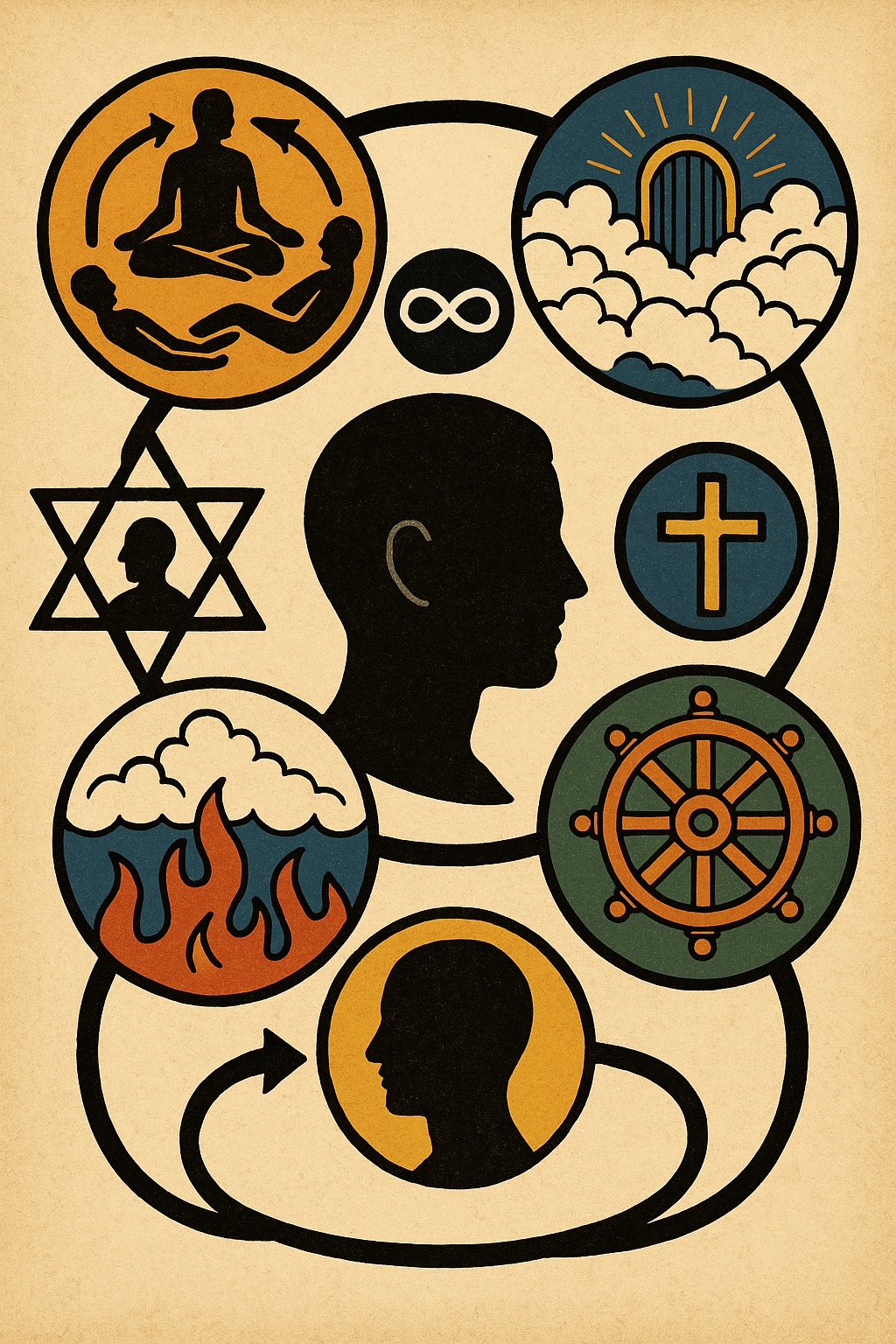Religions have one thing in common. They cannot accept the end. Death terrifies them. Nothingness feels unbearable. So they invent loops—reincarnations, heavens, and eternal returns. Each system promises continuity. None offers truth. Humans cling to illusions, hoping that existence never runs out. But the price of comfort is reason.
The fear of endings
Every religion was born from fear. People wanted to believe that dying is not the end. They imagined souls floating away, reborn, or judged. The idea of permanent extinction was too much to bear. So they turned to priests who promised that death was only another beginning. From that moment, faith became a contract: comfort in exchange for submission.
Hinduism and the wheel of samsara
Hinduism made existence a wheel. You live, you die, you are reborn—again and again. It calls this cycle samsara. Karma decides where you land next, but karma is not justice. It is control. It turns morality into accounting. You act well, you get promoted. You act badly, you fall. The game never ends. Moksha, the promised escape, remains a rumor. Nobody verifies it. The result is obedience disguised as spiritual progress.
Buddhism and the desire to end desire
Buddhism copied the same wheel but gave it a new label. The goal is nirvana—freedom from suffering. But the logic breaks. You must desire to stop desiring. You must strive to extinguish striving. The contradiction never resolves. Detachment becomes another form of attachment. What remains is quiet nihilism: a polite refusal to live fully.
Christianity and the eternal playground
Christianity built an infinite afterlife. Heaven and hell extend the human lifespan beyond all measure. The believer lives forever, either rewarded or punished. Yet eternal life solves nothing. It only multiplies boredom and injustice. Why should finite deeds earn infinite outcomes? The idea of resurrection turns death into theater. It denies mortality instead of understanding it.
Islam and the paradise without exit
Islamic paradise is another endless world. Gardens, rivers, and pleasures with no end. But endless pleasure means endless repetition. Eternity turns joy into routine. Worship never stops. Hell burns forever. Both are forms of eternal servitude. Instead of facing death, the believer enters an eternal monarchy where God rules without opposition.
Judaism and the waiting that never ends
Judaism is built on expectation. The Messiah will come. Justice will prevail. The suffering will end. Yet the story repeats for thousands of years. The cycle of hope and disappointment keeps the faith alive. The covenant never closes. The promise delays itself forever. What looks like endurance is actually stagnation.
Ancient cycles before religions grew up
Before prophets and scriptures, early civilizations already imagined circles. Egyptians believed in the sun god’s daily death and rebirth. Mayans built calendars of eternal time. Norse myths repeated creation and destruction endlessly. The pattern was everywhere. Nature’s rhythm—day and night, seasons, birth and decay—was mistaken for cosmic truth. Humans copied the cycles they saw and called them divine.
Modern spirituality and recycled superstition
Today’s spiritual market sells the same old myths with a new smile. Reincarnation becomes “energy transformation.” Karma becomes “universal vibration.” Quantum mystics mix science with fantasy. Self-help gurus promise that your “soul frequency” can attract wealth and love. Behind every crystal, mantra, and meditation app hides the same ancient fear—refusing to accept that existence ends.
The rise of contemporary New Age
The New Age movement is the religion of people who think they left religion. It speaks the language of science while selling the logic of myth; it promises cosmic balance, infinite souls, and lives recycled through universes. It offers fake empowerment, replacing priests with influencers. “Everything happens for a reason” becomes its gospel. Astrology, tarot, reincarnation, and energy healing form its scripture. It flatters the ego by turning the universe into a mirror of the self. Yet it still denies the end, still fears nothingness, still runs from truth.
The meaning of endings
Finality gives life shape. Without death, there is no urgency, no value, no beauty. If everything repeats forever, nothing matters. The acceptance of death is not defeat. It is liberation; it turns existence into art, not routine. It makes every moment unique because it will never return.
Breaking the loop
The only mature philosophy is the one that accepts the void. There is no heaven, no rebirth, no energy cycle—only life, once. That is enough. Meaning is not found in circles but in lines that end. The greatest courage is not faith. It is the acceptance of finality. The loop ends when we stop pretending it continues.
The eternity of death
Human life is a flicker. The universe existed for billions of years before you were born and will continue for billions after you die. Against that scale, life is almost nothing. A few decades of breathing, then silence forever. You will be dead for longer than stars will shine.
Religions cannot face that. They call it reincarnation, resurrection, or eternal life—anything but extinction. Yet the truth is simple: you will be dead for eternity. The brief moment of living is the exception, not the rule. Existence is a rare spark in an ocean of nonexistence.
If eternity exists, it belongs to death, not to life.
Further reading: There is no life after death: the ultimate guide
Further reading (free e-book): 250 Arguments for Atheism (Jan Bryxí 2025)

Leave a Reply